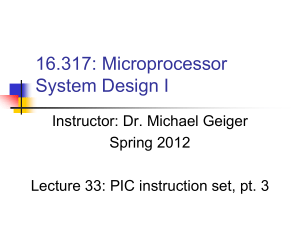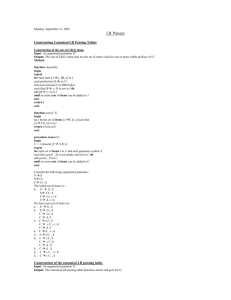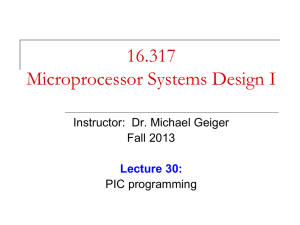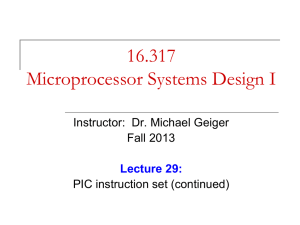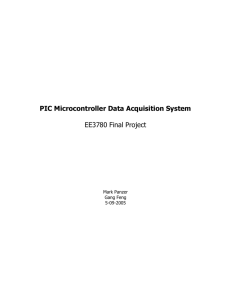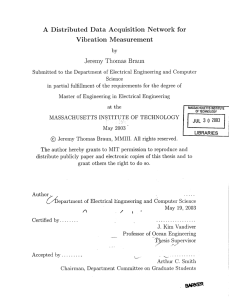Linear Pendulum Rangefinder for Education By
advertisement
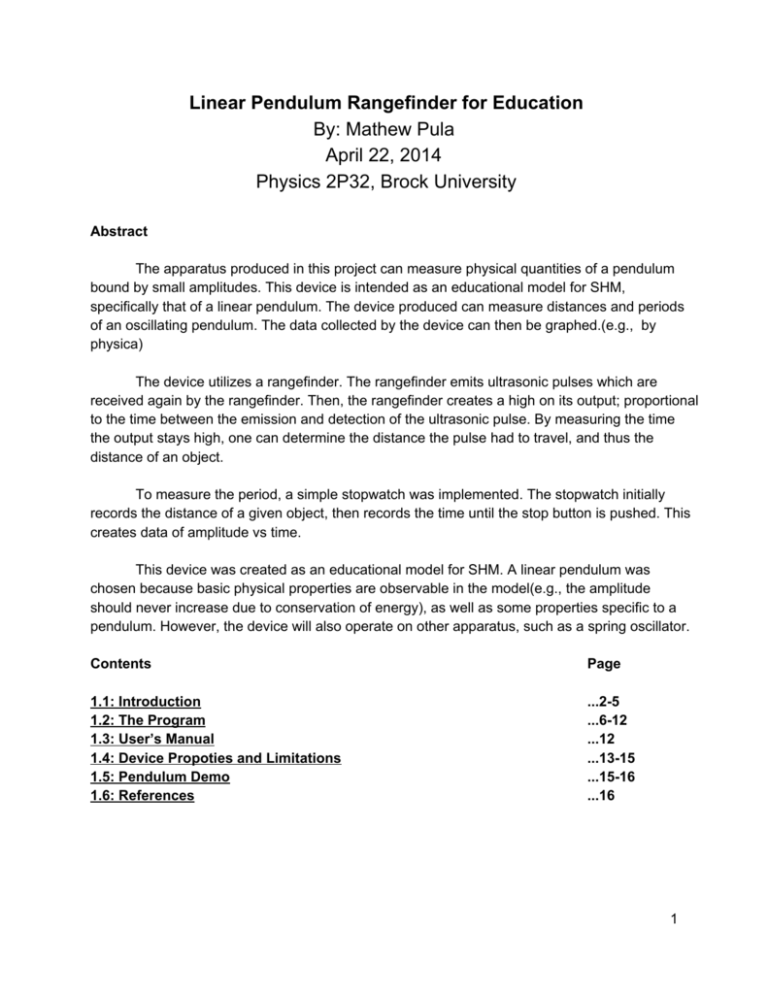
Linear Pendulum Rangefinder for Education By: Mathew Pula April 22, 2014 Physics 2P32, Brock University Abstract The apparatus produced in this project can measure physical quantities of a pendulum bound by small amplitudes. This device is intended as an educational model for SHM, specifically that of a linear pendulum. The device produced can measure distances and periods of an oscillating pendulum. The data collected by the device can then be graphed.(e.g., by physica) The device utilizes a rangefinder. The rangefinder emits ultrasonic pulses which are received again by the rangefinder. Then, the rangefinder creates a high on its output; proportional to the time between the emission and detection of the ultrasonic pulse. By measuring the time the output stays high, one can determine the distance the pulse had to travel, and thus the distance of an object. To measure the period, a simple stopwatch was implemented. The stopwatch initially records the distance of a given object, then records the time until the stop button is pushed. This creates data of amplitude vs time. This device was created as an educational model for SHM. A linear pendulum was chosen because basic physical properties are observable in the model(e.g., the amplitude should never increase due to conservation of energy), as well as some properties specific to a pendulum. However, the device will also operate on other apparatus, such as a spring oscillator. Contents Page 1.1: Introduction ...2­5 1.2: The Program ...6­12 1.3: User’s Manual ...12 1.4: Device Propoties and Limitations ...13­15 1.5: Pendulum Demo ...15­16 1.6: References ...16 1 1.1:Introduction: The sensor used in the project is a HC­SR04 Ultrasonic rangefinder. The device operates by emitting a bundle of ultrasonic pulses from an emitting device. This is done by setting the trigger high for a certain amount of time (~20μs was used in this project). Then, upon receiving the bundle of pulses in the receiving device, the sensor outputs a high signal on the echo output. The duration of the signal is equal to the time between the emission of the bundle and the reception of said bundle. From this, one can determine the distance by using a calibrated counter. In this project, the counter is calibrated to cycle ever 5.8μs. This gives the distance in millimeters. A timing diagram is shown below in figure 1.1.0. Figure 1.1.0 HC­SR04 Timing Diagram Taken from Cytron Technologies: HC­SR04 User’s_Manual The purpose of the device constructed in this project is to model the SHM of a linear pendulum. The device produced can model the position, x(t), of a pendulum or spring oscillator by providing data points; which can then be graphed. In addition, a stopwatch function has been included. This is to measure the period of oscillation, however it requires manual control. This device measures distance fairly precise and accurately and could be used for quantitative analysis. However the period measurements, hence relying on the judgment of the user, should not be used quantitatively. Instead, the period should be determined graphically. The device produced in this project is a distance measuring device. The device measures distance in millimeters, and outputs the data, along with a trial number, to the PICLab output. The trial number is added for graphing purposes. An example of this is shown below in figure 1.1.1. This process is automated. This mode is selected by pressing any button excluding reset and switch 2 on the Picboard. 2 Figure 1.1.1 Example Data Mode 1; left column = trial number, right column=distance(mm) In addition to the distance measuring technique mentioned above; this device can also measure the period of an oscillation. The program first measures the distance between the object in question and the Picboard. Then, a counter is run until a button (switch 2) is released. The countermeasures in milliseconds. This mode is selected by pressing switch 2 and is manual. An example of the data collected via this mode of operation is shown in figure 1.1.2. 3 Figure 1.1.2 Example Data Mode 2; left column=distance(mm), right column=time(ms) In terms of the oscillation of a pendulum, this distance will be the amplitude of oscillation, plus some constant distance (see figure 1.2.3). For the intended purposes of this mode of operation, it is not necessary to find the actual amplitude. It is only necessary to show that the amplitude may have changes between data points. 4 Figure 1.2.3 Constant Value Explanation N.B Angle in this diagram is exaggerated. The device can model the equation x(t)=A*sin(ωt + φ) +C i.e., the position equation for SHM; which is an important model in physics. The data has a small error, but not negligibly small. It also shows how much a simple measurement, such as the position, can do i.e., show conservation of energy, calculate amplitude, determine v(t), a(t), etc. This is important to those just introduced to physics, as it has a stigma of being difficult; in reality most things are fundamentally simple. The data output of the rangefinder synergies well with Physica. The device is also simple to use, having only a few operation buttons. For these reasons, this device makes an ideal educational tool for introductory mechanical physics. 5 1.2: The Program: The program can be explained with the flowchart, figure 1.2.1. This device operates Figure 1.2.1 Program Flowchart N.B some checking and clearing steps are omitted for compactness. 6 The entire program appears as: Rangefinder ;Effective angle 30 degrees ;Distance between 2cm­4m ;First, create a pulse TRIG equ 1; Define Trigger and ECHO equ 2; Echo channels incase ; they change on board Selector1 equ 0x26 THold equ 0x20 EHold equ 0x21 ECount1 equ 0x22 ECount2 equ 0x23 Graph1 equ 0x24 Graph2 equ 0x25 TimerC1 equ 0x27 TimerC2 equ 0x28 Bank1 ;Setting the Trigger bcf TRISE,TRIG ; set channel trigger to an output bsf TRISE,ECHO ; set channel Echo to input Bank0; end of preliminary operations Selector call Getkey; to select timer or distance movwf Selector1 movf Selector1,W sublw 7 btfsc STATUS,Z goto Selector movf Selector1,W sublw 2; pushing 2 selects timer btfsc STATUS,Z goto Timer clrf Graph1 ; clearing trial counters clrf Graph2 7 ;mode 1 Triggermovlw 250 ; This is for points per seconds, It is just to delay between data points call Wait incf Graph1 ; increment LSD counter btfsc STATUS,Z ; if LSD = 0, increment incf Graph2 ; MSD counter movf Graph1 W iorwf Graph2 W ; Test for 0 state, omitted from flowchart btfsc STATUS,Z goto END; end operation if 0 state movf Graph1 W movwf WL ; move counter 1 value to WL register movf Graph2W movwf WH ; move counter 2 value to WH register call Bin2BCD movlw 4; this selects the amount of trials possible call BCD2TCL movlw 0x20 call TxByte; at this point, the output is ready for a distance measurement bsf PORTE,TRIG ; ;Need to set Trigger high for ~20us movlw 32 ; Delay device movwf THold TWait decfsz THold; to delay signal deactivation goto TWait clrf ECount1; clear counters clrf ECount2 bcf PORTE,TRIG; Set trigger output low ;For Echo, we want distance to be in reasonable units ;As distance = 340/2 *t, if we want dist. in mm then t= 5.8823us ;therefore we want Echo clock to take 5880ns per cycle ;but cycles only in intervals of 200ns, so 5800ns 8 TIH movlw 3; this is to test if the echo input is high from the sensor movwf EHold DELAYdecfsz EHold goto DELAY nop btfss PORTE,ECHO; Test if high goto TIH ;Distance counter begins now Echo movlw 5 ; For delay to make 5800ns movwf EHold; to store delay value nop; for delay incf ECount1 ; increment LSD counter btfsc STATUS,Z ; if LSD = 0, increment MSD counter incf ECount2 ; MSD counter movf ECount1 W iorwf ECount2 W ; Test for 0 state btfsc STATUS,Z goto END; end if 0 state EWait decfsz EHold ; goto EWait ; for delay nop btfss PORTE,ECHO; Test if Echo is high, skip if yes goto Output ; go to output if ECHO is low goto Echo ; go to counter function 'Echo' if Echo input is high Output movf ECount1 W movwf WL ; move counter 1 value to WL register movf ECount2 W movwf WH ; move counter 2 value to WH register call Bin2BCD movlw 5 call BCD2TCL movlw '\n call TxByte; new line, output ready for new trial goto Trigger; loop to trial counter ; end of mode 1 9 ;mode 2 Timer call Getkey; test to see if 2 is pressed sublw 2 btfss STATUS,Z goto Timer clrf TimerC1; clearing counters of data clrf TimerC2; ; This is a repeat of the above distance counter bsf PORTE,TRIG ; Set trigger output high movlw 32 ; Delay device movwf THold TWW decfsz THold; to delay signal deactivation goto TWW clrf ECount1; clear counters clrf ECount2 bcf PORTE,TRIG; Set trigger output low ;total execution time between bsf and bcf is 10us. so x = (10000­(5*200))/(200*3)=15 ;For Echo, we want distance to be in reasonable units ;As distance = 340/2 *t, if we want dist. in mm then t= 5.8823us ;therefore we want Echo clock to take 5880ns per cycle ;but cycles only in intervals of 200ns, so 5800ns DLAY movlw 3 movwf EHold DELAY1 decfsz EHold goto DELAY1 btfss PORTE,ECHO; Test if high goto DLAY Echo1 movlw 5 ; For delay movwf EHold; to store delay value nop incf ECount1 ; incriment LSD counter btfsc STATUS,Z ; if LSD = 0, incriment incf ECount2 ; MSD counter movf ECount1 W 10 iorwf btfsc goto ECount2 W ; Test for 0 state STATUS,Z END; error if 0 state EWait1 decfsz EHold ; goto EWait1 ; for delay nop btfss PORTE,ECHO; Test if Echo is high, skip if yes goto Output1 ; go to output if ECHO is set goto Echo1 ; go to counter function 'Echo' if ECHO is low ;14 Output1 movf ECount1 W movwf WL ; move counter 1 value to WL register movf ECount2 W movwf WH ; move counter 2 value to WH register call Bin2BCD movlw 5 call BCD2TCL movlw 0x20 call TxByte; move amplitude to graphing output goto TTT TTT call Getkey; test to see if 2 is released, stop counter if 2 released sublw 7 btfsc STATUS,Z goto Output2; if yes output time incf TimerC1 ; incriment LSD counter 6 btfsc STATUS,Z ; if LSD = 0, incriment incf TimerC2 ; MSD counter movf TimerC1 W iorwf TimerC2 W ; Test for 0 state btfsc STATUS,Z goto END; error if 0 state nop ; for time delay movlw 89 movwf THold; 15 instruction cycles ; We want nice time units 1ms,(16+ 89*56)200ns =5(200)us=1ms TW movlw 17 movwf EHold TWT decfsz EHold goto TWT; 11 nop; for missing goto cycle decfsz THold goto TW; one TW loop is 17*3 + 5 =56 instruction cycles goto TTT; on last instruction, additional cycle here so 16 +89*56 cycles Output2 movf TimerC1 W movwf WL ; move counter 1 value to WL registar movf TimerC2 W movwf WH ; move counter 2 value to WH registar call Bin2BCD movlw 5 call BCD2TCL movlw '\n call TxByte; ready for new data goto Timer; loop to timer ;end of mode two END return; for ending purposes 1.3: User Manual: 1. load the program into the Picboard 2. Select a mode of operation. Switch 2 selects mode 2, any other button selects mode 1 3. If mode one is selected, press the reset button when the desired amount of trials are conducted and/or before the upper limit of trials is reached. 4. If mode 2 selected, hold down button 2 until desired time period is achieved, then release button 2. 5. Press button 2 again and repeat instruction 4 to conduct another trial. Press the reset button when the desired amount of trials have been conducted. *Device best operated within 30 degrees, operational range 2­400cm. For best performance, an object of area at least 0.5m2, not made of an acoustically absorbent material, should be used for detection. *Taken from Cytron Technologies: HC­SR04 User’s_Manual 12 1.4: Device Properties and Limitations When tested on a reasonably sized object(a picboard), the operational range of the rangefinder is greatly reduced. An object of similar size to a picboard should surpass no more than 50cm from the rangefinder and should not come closer than 2cm. From the manufacturer, the performance vs angle measurement is shown in figure 1.4.1. It can be said that the device operates most effectively within 15o from the axis of measurement. Figure 1.4.1 Performance vs Angle Taken from Cytron Technologies: HC­SR04 User’s_Manual The precision and accuracy of distance measurements is quite high, typically varying ±1mm, as shown in figure 1.4.2. The measurement listed in figure 1.4.2 is of a distance ≅30cm. Due to disciples in the origin i.e., it is difficult to determine the actual location of the sensor, all that may be said of the accuracy of the device is that it is accurate to within 5mm w.r.t. the picboard. When analysing the accuracy of the device, the resolution of the counter should be considered. The test, for the echo output to go high, has an associated resolution of 13 instruction cycles. Also, the counter itself has an associated resolution of 29 instruction cycles. This creates an error of about ± 1.428mm((13+29)*200*10­9*340/2). In addition, the device has associated errors with the speed of sound in air, as this is variable and dependant on environment. Additionally, there is a rounding error associated with the counter cycle. The actual period of the cycle should be 5.8823μs (d=v/2*t→ t=2*10­3/340). This implies that the counter has an overestimation of about 1.42%(5.8823/5.8). 13 Figure 1.4.2: PICLab Output Data at 30cm The time resolution of the device, in the distance measuring mode, is variable and may be approximated by 38.75ms +(5.8μs*distance). The constant term is due to the wait function applied at the beginning of the program. The variable term is the time required to count to a specific distance. This gives a minimum time resolution of about 38.9ms and a maximum of 0.419s. 14 It should be noted that the maximum distance, time and trial values which may be obtained is 216­1. However, for the applicational purposes of the device, these values would never be obtained. In practice, the distance values should never surpass 4m and 9999 trials is sufficient for any sized pendulum or oscillator. The accuracy and precision of mode 2, the timing mode, is not determinable; due to the dependance of a human input(pressing and releasing the button). Thus, it is not viable to use the measurements obtained for qualitative purposes. The feature was included only to show the independance of period from amplitude for the linear pendulum(i.e., to be able to change the amplitude in the same data set). To calculate the actual period, it is advised that one uses mode 1 to acquire distance data and utilize a graphing program capable of fitting functions to data(e.g., Physica). 1.5: Pendulum Demo: The equation of a linear pendulum, x(t)=A*sin(ωt + φ) +C, is only applied for linear pendulums. For the purpose of a demonstration of mode one, small angle approximation will be used; so that the data will approximate a linear pendulum well. In addition, if the amplitude of the pendulum is too large, the rangefinder will not be able to detect it, as it will pass the optimal angle threshold. The period of a linear pendulum can be found with the following equation: T=2π(I/mgL)½. in the case of a simple pendulum, this reduces to T=2π(L/g)0.5. The period of a non­linear, simple pendulum is T=2π(L/g)0.5sin(θ)(Period equation taken from Georgia State University, HyperPhysics). This implies the period should remain constant, within experimental error, until a sufficient amplitude is exceeded. This will be tested by the second mode of operation. Note that the amplitude values obtained in mode two will not reflect actual amplitude values. This is especially true once the amplitude begins to affect the period, as this is when the small angle approximation is no longer valid. This is shown in figure 1.5.1. As the sum of the vectors in not zero, the amplitude measurements would be off if the constant value method was used, hence the data the rangefinder gives is a magnitude only. 15 Figure 1.5.1 The Effect of Exceeding Small Angles on Amplitude 1.6: References: Cytron Technologies: HC­SR04 User’s_Manual, https://docs.google.com/document/d/1Y­yZnNhMYy7rwhAgyL_pfa39RsB­x2qR4vP8saG73rE/e dit?pli=1 Georgia State University, HyperPhysics, Mechanics: Periodic Motion; http://hyperphysics.phy­astr.gsu.edu/hbase/permot.html#permot 16


